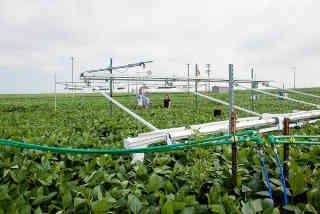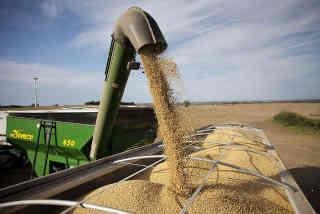By Susan Cosier
On Adam Jones’s 750-acre farm in central Missouri, corn is ripening and soybean pods are getting plump. But the past summer has been particularly hot, says the fourth-generation farmer, and that doesn’t bode well for this fall’s bounty. In July, temperatures climbed above 90 degrees Fahrenheit for more than a week, with the heat index exceeding 100. Then came the rain. At the end of the month, 11 inches of rain fell on Jones’s farm in less than 24 hours, flooding his fields. When it comes to weather, he says, “There is no normal anymore.”
With higher temperatures and changing precipitation patterns, climate change has been affecting America’s Breadbasket for a while now. A decade ago, the Midwest experienced the worst drought and heat stress it had seen in 50 years. The impact hit nearly 80 percent of farmland in the region, strained livestock production, and raised food prices around the world. And the weird weather hasn’t let up since.
Climatologists say that extreme weather events are already occurring more often than previously predicted, and that conditions like those experienced in the Midwest over the past decade will only repeat themselves with more frequency as the climate continues to warm.
“I think everybody's been taken aback by the predictions that extreme events will become more common,” says Steve Long, a plant biologist at the University of Illinois. “But I think it's happened at a scale that nobody quite expected.”
Longer droughts, along with deluges that inundate fields in shorter periods of time, can have devastating effects on agricultural yields. But researchers are also looking into how heat waves could sizzle crops.
The Extreme Heat Belt
The National Weather Service classifies days with heat indexes of 125 degrees and above as “extreme danger,” or when the risk of heat strokes is highly likely. A recent report published by the First Street Foundation, a nonprofit dedicated to quantifying and communicating climate risk, warns that 50 U.S. counties could experience heat indexes of 125 degrees Fahrenheit in 2023. But over the next three decades, such heat is expected to occur in 1,023 counties, where, collectively, nearly 108 million people live. Dubbed the “Extreme Heat Belt,” this large swath of the country stretches from northern Texas and Louisiana up through Illinois and Indiana and as far north as Wisconsin.
Heat indexes that high would be an immediate health concern for farmworkers (and anyone else without access to air-conditioning). Such extremes also wreak havoc on the plants and animals that provide us with food and sustain rural economies.
“More farmers are using it, and a lot of it is due to these extreme weather events that we’re seeing,” she says. O’Connnor and her team have been working in the Midwest on policies that would give farmers a “good driver discount” on their insurance if they farm in ways that make their crops more climate resilient. If passed, the COVER Act, introduced to the House this summer, would deduct $5 per acre to farmers who plant cover crops, and allow the U.S. Department of Agriculture (USDA) to explore discounts for other practices, such as composting and crop rotation.

Scientists Carl Bernacchi (left), Don Ort (center), and Lisa Ainsworth (right) in a plot of soybeans treated with elevated carbon dioxide at the SoyFACE Global Change Research Facility at the University of Illinois Research Farm
Institute for Genomic Biology/University of Illinois via USDA
Heat stress and crop yields
At the University of Illinois, plant biologist Carl Bernacchi is heating things up. On experimental plots, he simulates heat waves with an array of infrared lights and measures their effects on corn and soybeans.
At first, researchers thought that as the climate warmed and carbon dioxide concentrations rose in the atmosphere, plants would grow more quickly and become more productive, “but we actually see the opposite in most years,” says Bernacchi, who also works for the USDA. Higher temperatures seem to interfere with photosynthesis and result in lower biomass and yield.
Early in the season, when Bernacchi induced a heat wave—12 degrees Fahrenheit higher than the average for that time of year—the plants fared OK. When he did the same during their reproductive stage, however, yields decreased.
Heat waves, and warmer temperatures in general, affect agriculture in other ways—but not all of them are bad. When they occur more often and earlier in the year, they may cause crops to cycle through reproduction faster. This scenario could lead farmers to grow multiple rounds of crops in the summer. This could be a boon for production—as long as severe spring storms don't keep them from the fields, delaying planting or destroying seeds already sown. Recent research shows that, in the past seven decades, roughly 43 percent of spring floods caused crop losses.
Warmer temperatures also evaporate more moisture within the soil and plants. This adds water vapor to the surrounding air and may help keep temperatures from getting as high locally as they do outside of a sea of agriculture fields. But hot weather also dries out the land, which can lead to and exacerbate drought, creating a situation where crops no longer have the moisture they need. Even if the surface temperature is cooler due to agriculture, plants remain susceptible to the impacts of heat waves, which can slash farmers’ yields.

Local fields, global consequences
Various agricultural technologies have caused corn and soybean harvests to increase over the past three decades. On Jones’s farm, for example, yields have risen roughly 10 percent in 10 years. Jones plants cover crops, which help trap carbon and keep moisture in the soil, but even so, he expects future harvests to be smaller when summers are as hot as they were this year.
And what happens in the Midwest doesn’t always stay in the Midwest. Agriculture covers 127 million acres of the region, with corn and soybeans growing on 75 percent of them. Those fields supply more than 33 percent of the world’s corn and 34 percent of the world’s soybeans, most of which are processed into meal for livestock. A heat wave here can contribute to food shortages in the global marketplace, and add to other climate-driven supply issues that may be happening elsewhere. Extreme weather is affecting agriculture across the globe, with corn yields, for example, expected to decrease by more than 20 percent by 2070. Livestock is also likely to suffer, as it did in Kansas this past June when 2,000 cattle died in temperatures that topped 100 degrees. (Some farmers put up shelters to provide shade for their animals and changed the bedding in the pens to keep the ground from getting so hot.)
Learning ways to adapt to extreme heat is critically important to the global food supply and the health of farmworkers. And you don’t have to look far to see the interconnections between climate, food scarcity, and political stability.
Click here to see more...